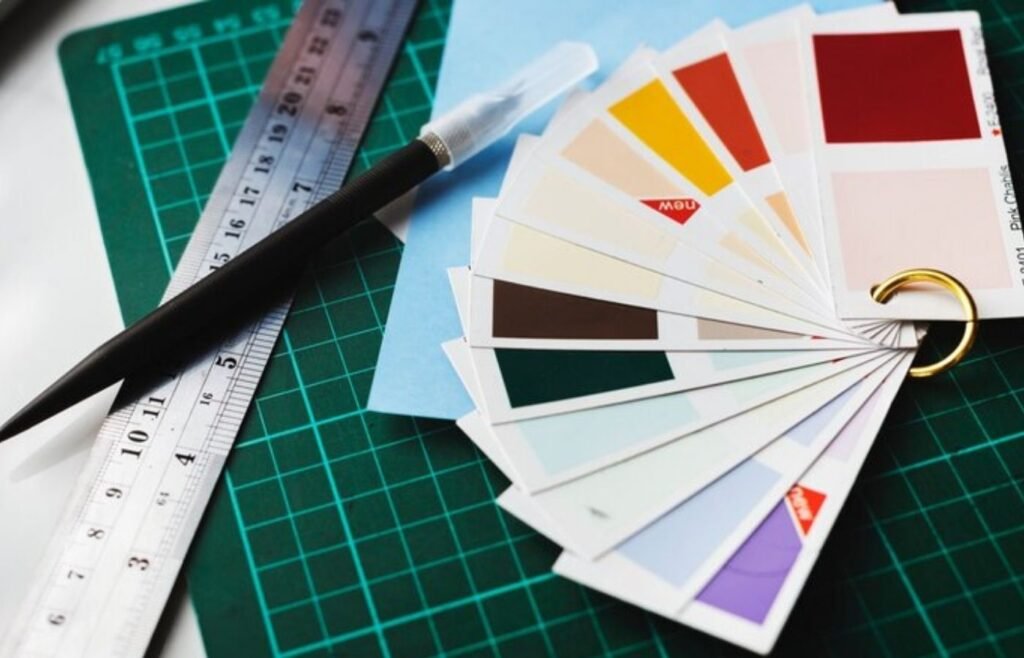Whether you’re decorating a new office or redecorating your home, selecting an interior design and color scheme can be overwhelming. With all the options available, it’s hard to know where to start!
Thankfully, there are tricks to finding colors that look good together. By breaking down color schemes into basic categories like monochromatic and complementary, you can find colors that will look great in any room.
In this article, I’ll share some of my favorite color combinations as well as other tips on how to discover great interior design and color scheme ideas.
Interior Design Ideas
Minimalist: Simple and clean lines, neutral color palette, and plenty of negative space
Minimalism is an interior design style that leans towards simplicity and understated elegance. It employs simple and clean lines, neutral color palette, and plenty of negative space to create a sophisticated, minimalistic look.
Minimalism is derived from the philosophy that less is more, hence fewer things in the room lead to a sense of calmness and focus. That’s why simplicity is key when it comes to achieving this style.
The best part about a minimalist aesthetic? It can be adapted to traditional or contemporary designs. If you opt for a traditional look but want it with minimalism twist, choose pieces made of wood instead of metal furniture.
For your color palette, stick with neutrals like white, cream, greys and light blues or pastel colors which evoke a sense of peace and tranquility. To create visual contrast use accents of dark colors here or there for dramatic effect!
Scandinavian: Light wood tones, natural fibers, and monochromatic color scheme
The Scandinavian style of interior design is marked by its light wood tones, natural fibers and a monochromatic color scheme. You’ll find in this style a clean, bright open space that invites plenty of natural light and airy accents.
Think bright whites complemented with pops of muted earth tones, as well as some bold colours thrown into the mix. This is a look that feels comfortable yet offers just enough contrast to create interest and depth.
Natural materials like granite, brick and wicker are often seen paired with textiles made from cotton or linen. This design style can range from rustic to modern depending on which unique touches you decide to add but all feature a warm minimalism that is refreshing and calming at the same time.
Rustic: Warm earthy colors, natural materials like stone and wood, and a cozy, cabin feel
If your space needs a touch of rustic, you can use earthy tones and natural elements to create a cozy, cabin feel. Brown and green paint shades come to life on the walls when combined with wood furniture pieces that are naturally well-seasoned.
To really bring out the rustic decorations, incorporating materials like stone to any fireplace mantel or wall cladding will provide a contrast of texture. Don’t forget about bringing in heaps of soft furnishings like rawhide rugs and artisan blankets too!
For the stylish rustic look always try adding unique accent pieces such as antler chandeliers or brass wall hooks. These details will add a perfect finishing touch and envelope your home with warm memories of times spent in nature.
Industrial: Exposed brick, concrete, and metal elements, and a neutral color palette
Industrial design is characterized by exposed brick, concrete and metal elements, along with a neutral color palette. This minimalist approach creates a gorgeous raw setting that’s both inviting and industrial at the same time.
The contrast between the stark lines of concrete and metal against the warmth of wood highlights the unique look that defines this style. The use of muted colors such as grays and whites results in an atmosphere of sophistication and sophistication.
One thing to keep in mind when creating an industrial-style space is that you don’t have to go overboard with your design elements. Balance is key—you can mix vintage pieces with new, modern pieces to create an eclectic vibe that still works together harmoniously.
A rug or throw blanket can soften any hard edges and act as a grounding element for your overall design scheme. With the right touches, you can create a beautifully composed industrial-style home that’s perfect to show off!
Mid-Century Modern: Bold graphics, clean lines, and a mix of organic and geometric shapes
Mid-Century Modern decor is all about making a bold, yet minimalist statement. It’s characterized by bright colors, clean lines, and a mixture of organic and geometric shapes that create an inviting atmosphere.
The key to creating the perfect mid-century modern look is to carefully select furniture pieces with geometric shapes and lines. The frames for your sofa and chairs should be made of metal or wood with rounded edges and small legs.
Choose from unique patterns such as circles, diamonds, squares, stripes, and more to add texture and interest to the design. Accentuate with bold pops of color by adding pillows in warm tones like oranges, yellows, greens and blues.
Finally use accessories such as rugs, curtains and wall art in Mid Century Modern style to complete the look!
Bohemian: Bright colors, eclectic mix of patterns, natural textures, and vintage finds
If you’re a fan of the vibrant, Bohemian look, you’ll love interior design and color scheme ideas that use bright colors with eclectic patterns. You can create a warm and inviting living space with rugs, curtains, and throw pillows in eye-popping hues.
Bohemian interiors are natural and relaxed, filled with vintage finds and unique pieces that add character and personality to any room. Natural textures like wood, woven baskets, and rattan create visual interest while creating an uplifting space at the same time.
Pair all this together by mixing different patterns in your bohemian decor such as stripes, plaids, tartans, paisleys – the possibilities are endless! You can keep going until you get the perfect mix of colors and textures that make you feel energized every time you walk in the room.
Color Scheme Ideas
Monochromatic: A single color in different shades, tints, and tones
Interior design color schemes don’t have to be difficult. Monochromatic is one of the simplest, yet most effective, ways to decorate a room.
Monochromatic means using a single color in different shades and tones. For example, you could use white with various others shades of white like off-white, eggshell or cream.
This can create an incredibly elegant look with the varying hues, while still providing cohesiveness throughout the entire space.
Combining monochromatic colors gives your interior design an effortless and cohesive look. With some skillful placements and combinations, you can create a stunning visual that will draw the eye to certain parts of the room.
Complementary: Two colors opposite each other on the color wheel
The Complementary color scheme is one that uses two colors directly opposite each other on the color wheel. Typically, these two colors create great contrast when used together.
When you implement a complementary scheme, you get the most impact from this only if the two opposing colors are used in equal parts. The effect itself is very striking and demands attention making it an ideal choice for high impact interior design.
For example, pair bold blue walls with its opposite yellow for a visually stimulating living space. Use these two shades to form a bold or subtle basis for the entire room depending on how much of these hues you use.
Analogous: Three colors next to each other on the color wheel
Analogous color schemes are best suited for smaller spaces, like bedrooms, because they provide a restful atmosphere. To create an analogous scheme with three colors, pick a dominant hue and then choose the colors to either side of it on the color wheel.
For example, if you want to use the analogous scheme in your bedroom, you can pick navy blue as your base color and pair it with light turquoise and slate gray. With this combination, you’ll have an incredibly tranquil and calming atmosphere.
The beauty of this scheme is that even though you’ve used three colors, there’s still some room for variety so you don’t feel too constrained by it. Try adding hints of other shades or pairing different textures to add depth to the design. That way, your interior design project will come alive with energy and life!
Triadic: Three colors equally spaced on the color wheel
The triadic color scheme is perfect for creating a visually pleasing color palette. It’s based on three colors that are equally spaced and look great together because of their contrast.
You can get creative with triadic color schemes, whether it’s for interior design, fashion or art. Plus, you can incorporate tints, shades and tones of each colour to create unique hues and depth in the design.
Triadic combinations can be tricky if you don’t know what you’re doing, but with understanding and practice, you’ll master it in no time! To make sure you strike the right balance between all three colors, reference an RGB or CMYK color wheel – they will be your best friend in figuring out harmonious palettes.
Neutral: A mix of black, white, gray, beige, and brown
Neutral colors are versatile and can make a great backdrop for any interior design. Neutral color schemes like black, white, gray, beige, and brown create a light, pleasant atmosphere that goes with almost any decor.
Neutral tones are calming and sophisticated, perfect for creating a timeless design. Incorporating soft neutrals in your home will keep it fresh without being overwhelming.
These colors bring balance to your space while providing a subtle elegance and warmth. A neutral palette allows you to add pops of bold color here and there without making the room too busy or cluttered.
You can choose one or two dominating neutrals and mix them with accent shades to create an eye-catching palette that works in harmony together.
Bold: Bright, attention-grabbing colors, such as red, yellow, or blue
Bold colors are the perfect way to add a touch of vibrancy and personality to your home. Colors like red, yellow, and blue make for a powerful interior design statement.
If you’re looking to make an impression in one room, such as an entryway or living space, consider bold colors! Red can be energizing and exciting, yellow is cheerful and uplifting, while blue can be calming and bring out a sense of peace.
For more definition with the bold colors, you can pair two bold shades together or tone down the intensity with black or white accents. Bold trends are here to stay so go ahead and take advantage of the creative possibilities that await!
Bottom Line
When it comes to interior design, the color scheme you choose is an essential element that can make or break the overall look of a room.
Whether you’re looking for something contemporary or classic, light and airy or bold and daring, there are endless combinations of colors that can fit your vision. Take some time to explore all the possibilities so you can create a stunning result that perfectly expresses your style.













